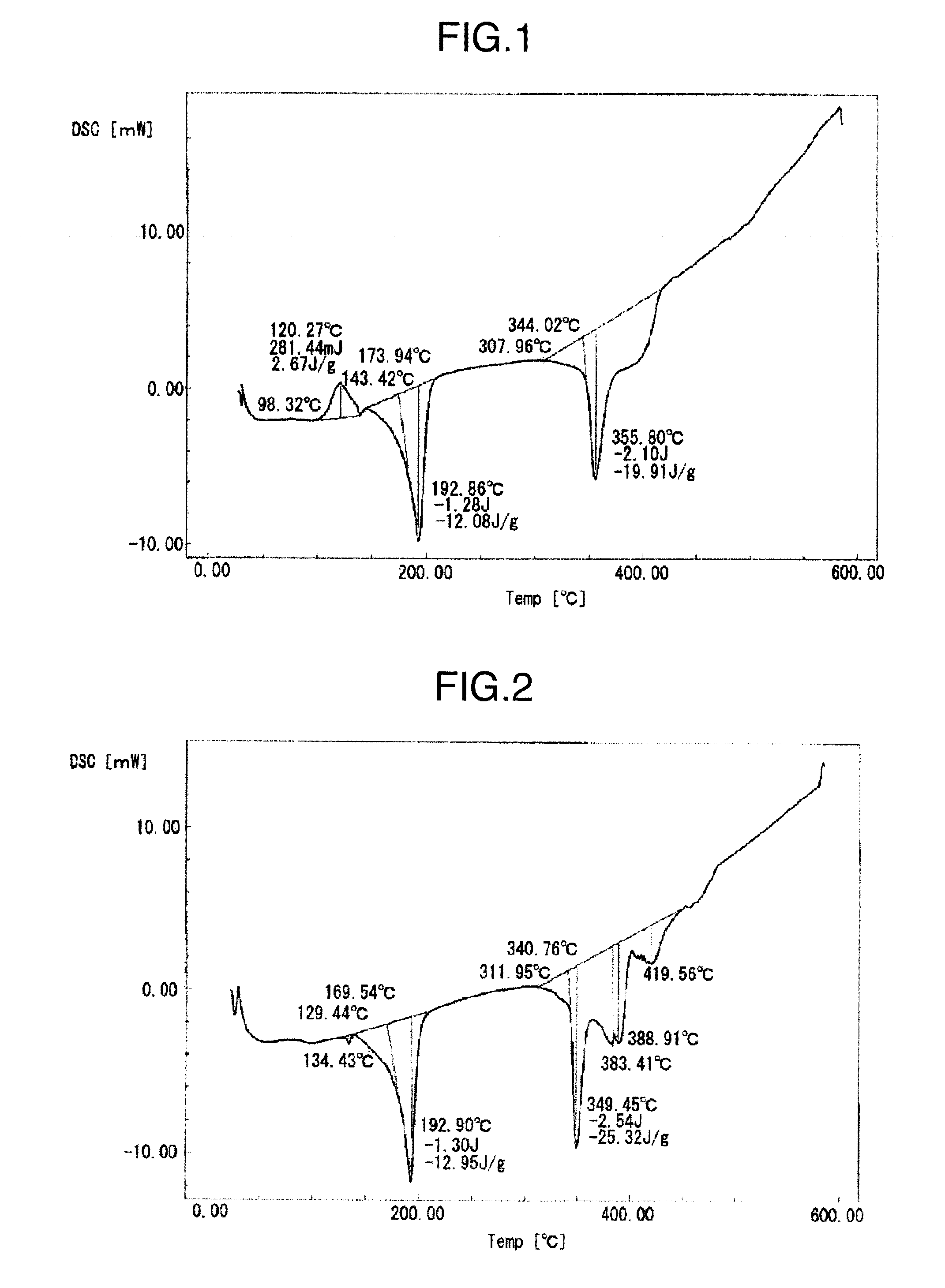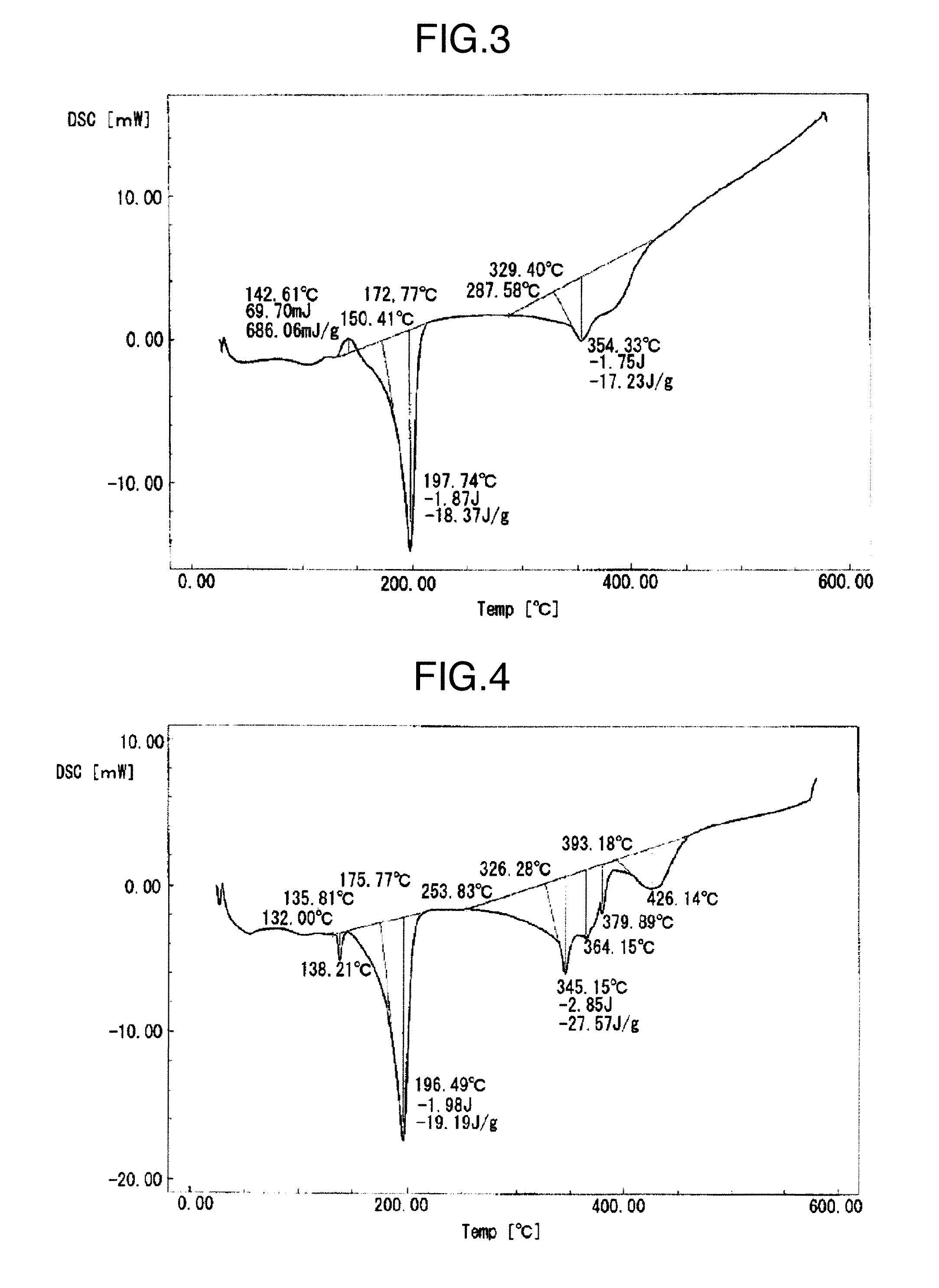Conductive Filler
a technology of conductive filler and conductive layer, which is applied in the direction of soldering apparatus, manufacturing tools, and capacitors, etc., can solve the problems of rare resource, poor ductility, and insufficient melting point reduction, so as to reduce manufacturing costs and environmental load, reduce thermal damage to components, substrates and peripheral devices during mounting, and reduce the effect of environmental load
- Summary
- Abstract
- Description
- Claims
- Application Information
AI Technical Summary
Benefits of technology
Problems solved by technology
Method used
Image
Examples
examples
[0042]Hereinafter, the present invention will be described according to the Examples.
[0043]Here, the differential scanning calorimetry was conducted under a nitrogen atmosphere at a temperature rising rate of 10° C. / min in the range of 30 to 600° C. using “DSC-50”, made by Shimadzu Corporation.
(1) Manufacture of First Metal Particles
[0044]1.0 kg of Cu particles (purity: 99% by mass or more), 4.8 kg of Sn particles (purity: 99% by mass or more), 3.2 kg of Ag particles (purity: 99% by mass or more), 0.5 kg of Bi particles (purity: 99% by mass or more) and 0.5 kg of In particles (purity: 99% by mass or more) were put in a graphite crucible, and heated up to 1,400° C. and melted under an atmosphere of helium of 99% by volume or more by a high frequency induction heating apparatus. Then, the melted metal was introduced from the tip end of the crucible into an atomizing tank under a helium gas atmosphere, and thereafter atomized to fabricate first metal particles by ejecting helium gas (p...
example 3
(3) Manufactures of a Metal Particle Mixture and a Solder Paste
[0057]A metal particle mixture (average particle size: 4.9 μm) was fabricated by mixing the first metal particles (a) and the second metal particles (a) in the weight ratio of 100:95. The metal particle mixture was made as a conductive filler in Example 3. A DSC chart obtained by the differential scanning calorimetry of the conductive filler is shown in FIG. 1. As shown in FIG. 1, the presence of endothermic peaks at 193° C. and 356° C. is confirmed. The endothermic peak at 193° C. corresponds to a melting point of 174° C. (melt-starting temperature: solidus temperature). An exothermic peak at 120° C. is characteristically present.
[0058]Then, 90.0% by mass of the conductive filler, 6.4% by mass of a rosin flux, 1.6% by mass of triethanolamine (oxidized film removing agent), 0.4% by mass of stearic acid (active agent) and 1.6% by mass of ethylene glycol monohexyl ether (solvent) were mixed, and sequentially subjected to a...
examples 1 and 2
, and Examples 4 to 9
[0067]Respective metal particle mixtures in which the mixing ratios of the first metal particles (a) and the second metal particles (a) or the second metal particles (b) are changed as described in Table 1 in the conductive filler of Example 3 described above, were fabricated, and made respective conductive fillers of Examples 1 and 2 and Examples 4 to 9. The conductive fillers were made into pastes by the same method as in Example 3; the pastes were subjected to the heat treatment; thereafter, the chip bonding strengths were measured, and the results are shown in Table 1. A DSC chart obtained by the differential scanning calorimetry of the conductive filler of Example 5 is shown in FIG. 3; and a DSC chart obtained by the differential scanning calorimetry of the solder paste fabricated from the conductive filler after the peak-181° C. heat treatment is shown in FIG. 4.
PUM
| Property | Measurement | Unit |
|---|---|---|
| temperature | aaaaa | aaaaa |
| temperature | aaaaa | aaaaa |
| temperature | aaaaa | aaaaa |
Abstract
Description
Claims
Application Information
 Login to View More
Login to View More - R&D
- Intellectual Property
- Life Sciences
- Materials
- Tech Scout
- Unparalleled Data Quality
- Higher Quality Content
- 60% Fewer Hallucinations
Browse by: Latest US Patents, China's latest patents, Technical Efficacy Thesaurus, Application Domain, Technology Topic, Popular Technical Reports.
© 2025 PatSnap. All rights reserved.Legal|Privacy policy|Modern Slavery Act Transparency Statement|Sitemap|About US| Contact US: help@patsnap.com


